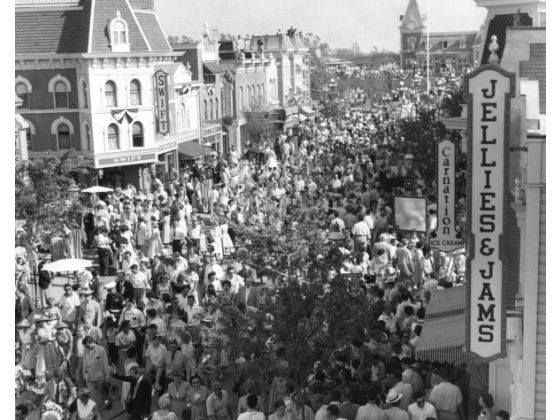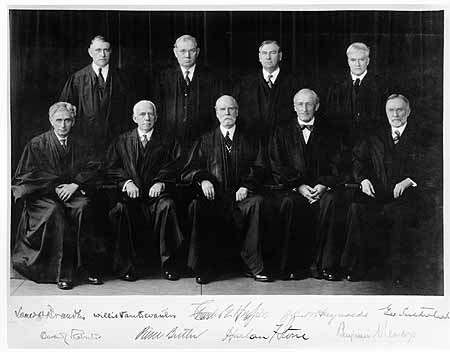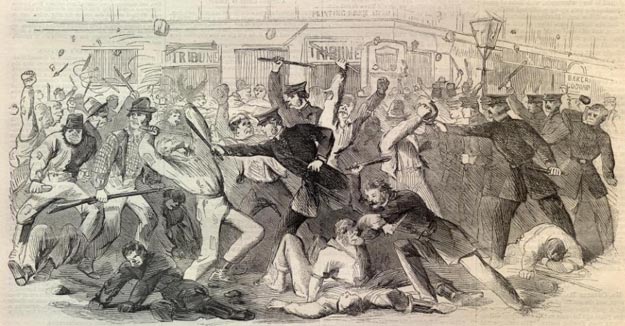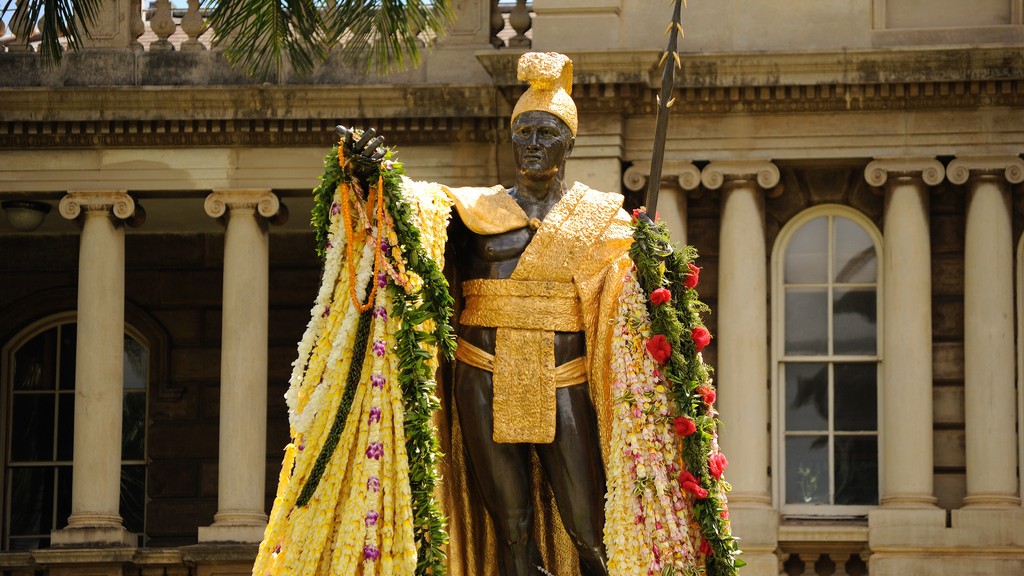On May 29, 1953 Edmund Percival Hillary and his sherpa guide Tenzing Norgay reached the summit of Mount Everest. He had been part of an unsuccessful expedition to Everest two years earlier.


On May 29, 1953 Edmund Percival Hillary and his sherpa guide Tenzing Norgay reached the summit of Mount Everest. He had been part of an unsuccessful expedition to Everest two years earlier.

Disneyland opened sixty years ago at 2:30 pm on July 17, 1955. At 4:30, there was a live TV broadcast with Walt Disney officially opening the park with this statement, “To all who come to this happy place: welcome. Disneyland is your land. Here age relives fond memories of the past…and here youth may savor the challenge and promise of the future. Disneyland is dedicated to the ideals, the dreams and the hard facts which have created America … with the hope that it will be a source of joy and inspiration to all the world.”
To say things didn’t go smoothly would be an understatement. It was an invitation-only event that expected 11,000 attendees. Thanks to counterfeit tickets, there were 28,000 people there. The huge crowd caused a traffic jam (as if that never happens at any of the parks now!), they ran out of food, and a plumbers’ strike meant that Disney had to choose between working toilets and drinking fountains. (He wisely, IMO, chose toilets over water fountains.) Rides broke down and a gas leak in Fantasyland caused it, Adventureland, and Frontierland to be closed for the afternoon.
The open-to-the-public opening was the next day, Monday July 18, 1955 at 10:00 am. People were already lining up at 2:00 am to visit Main Street USA, Frontierland, Fantasyland, Adventureland, and Tomorrowland (which included the Monsanto Hall of Chemistry). Over a million visitors came during the first seven weeks and it has had over 650 million visitors in the last 60 years.

President Franklin D. Roosevelt (Democratic) was frustrated by US Supreme Court decisions that overturned some important parts of his New Deal legislation. Emboldened by his fourth election as US president in 1936, he introduced a bill to add members to the Supreme Court. The Judicial Procedures Reform Bill of 1937 would have allowed the president to add up to six additional members for each Supreme Court justice that was over the age of 70 years and 6 months.
The bill was viewed as an attempt to lessen the independence of the Judicial Branch of the government and even though there were Democratic majorities in both the House and the Senate, it did not pass.
It still could be considered a success since the Court stopped invalidating New Deal legislation, including one (Helvering v. Davis) that decided that the Social Security tax was constitutional. Next time you look at the FICA deduction on your pay stub, you’ll know who to thank.

The San Diego Comic-Con (SDCC) is the largest Comic-Con in the world. It’s a four and a half day event, Thursday through Sunday with a Preview Night on Wednesday.
It began as a small comic book minicon in March 1970, lasting just one day. The success of that event let them have a three-day convention in August of the same year. The convention was held in hotels and other locations for the first two decades. It moved to the San Diego Convention Center in 1991.
It attracts fans of a variety of entertainment types and genres. (It has about 130,000 attendees per day.) There are a range of panels covering many facets of popular arts, seminars, workshops, awards, autograph signings, and a cosplay masquerade contest.
List of things to do in San Diego outside the con.

When you hear the phrase “draft riots” do you think of the Vietnam Era and burning draft cards? There were lots of protests against that war, but the NYC Draft Riots came earlier. Much earlier. It was the largest civil insurrection in U.S. history.
It was 1863 and there was a new military draft lottery in NYC to draft men to fight for the Union army in the U.S. Civil War. All male citizens between the ages of twenty and thirty-five were eligible, as were all unmarried men between the ages of thirty-five and forty-five. Men with means could either hire a substitute or buy their way out of the army for $300, that would be over $5000 today, adjusted for inflation. While blacks could, and did, join the army, they were not subject to the draft because they were not considered citizens.
It started with protests – demonstrations against the first federally mandated conscription laws in the United States – but quickly became violent riots that lasted for four days.
The city had always been divided on the subject of the Civil War. There had been calls for the city to secede from the Union, it depended heavily on the slave trade and had strong business ties to the South. Democratic Party leaders incited people with stories about how the Emancipation Proclamation would leave New York overrun by freed slaves.
Early Monday morning on July 13, 1863, the riots began. A group of firefighters who were mad about the conscription of their chief began smashing windows of the city’s Provost Marshall’s office. The mob that had formed outside followed them in and began destroying draft equipment.
Another early target was the offices of the New York Tribune newspaper because it was pro-war. (The editor, Horace Greeley was an abolitionist.)
By the afternoon the attackers had begun going after black people. The mob went to the Colored Orphan Asylum (the children had been safely removed shortly before) and destroyed clothing and toys and then set the building on fire. The destruction took only 20 minutes.
They were temporarily slowed by a night of heavy rain but were back out the next morning, ready for more mayhem. They destroyed downtown businesses and constructed barricades to keep the police away.
One black man, William Jones, was lynched. Jeremiah Robinson was beaten and drowned. A black sailor, William Williams was stabbed and stomped on, then stoned.
Col. Henry O’Brien who was in charge of the 11th New York Volunteer Infantry Regiment was also killed when he was coming to the aid of police fighting the rioters. The mob had withdrawn and O’Brien had walked down the street to a drugstore. Unfortunately, a group of rioters returned and attacked him. He was beaten, stoned, kicked, and then tortured to death. A black coachman, Abraham Franklin, was removed from his home and hanged, then dragged dead through the streets by his genitals.
They attacked white abolitionists and prominent Republicans. The mob burned down the home of Abby Hopper Gibbons, an abolitionist and social activist.They attacked two white women, Ann Derrickson and Ann Martin, who were married to black men.
White dock workers and longshoremen who had resented having to work with blacks attacked any buildings near the docks that catered to black clients – boarding houses, dance halls, tenements, and brothels. The businesses were destroyed and their white owners were stripped naked and left in the streets.
The New York state militia and other troops were called in to put down the riots. Many of the federal troops had just come from the battle at Gettysburg.
City Democrats put forth a bill to provide low interest loans for draft exemptions, Republican Mayor George Opdyke vetoed it, but the veto was overturned. This was the era of the Tammany Hall run city government which continued to grow in power by fighting for the rights of white working men.
Over 100 people died. Hundreds of buildings were damaged, some burnt to the ground, but only 67 people were convicted for their violent attacks and none of them received a meaningful sentence.
The draft was restarted a month later. Out of 80,000 men drafted from the state of New York, fewer than 2,400 actually went into the army. The rest had physical deferments or other exemptions.

The last time the whole band played together was July 9, 1995 at Soldier Field in Chicago, IL. Founding member, songwriter, and singer Jerry Garcia died the next month on August 9. 20 years after that last performance, the remaining four original band members will be back at Soldier Field to play a series of three concerts on July 3, 4, and 5, 2015 to celebrate the 50th year since the band’s founding.
Also joining them for the 50th anniversary concerts are Trey Anastasio, Jeff Chimenti, and Bruce Hornsby.
Here’s a video of the 1995 concert.
The 1995 set list was:
Touch of Grey
Little Red Rooster
Lazy River Road
When I Paint My Masterpiece
Childhood’s End
Cumberland Blues
Promised Land
Shakedown Street
Samson and Delilah
So Many Roads
Samba in the Rain
Corrina
Drums
Space
Unbroken Chain
Sugar Magnolia
Black Muddy River
Box of Rain
You can download the audio for free here.

If you think this is about England’s George III, guess again. The Kingdom of Hawaii was a sovereign state from 1810 to 1893 when the monarchy was overthrown. It then became an independent republic from 1894 to 1898 when it officially became a territory of the United States.
Kalani Paiʻea Wohi o Kaleikini Kealiʻikui Kamehameha o ʻIolani i Kaiwikapu kauʻi Ka Liholiho Kūnuiākea (King Kamehameha I, also called Kamehameha the Great) descended from chiefs from Hawai`i and Maui. When the warrior and future king was young, he was receptive to trade from Western explorers, acquiring both weapons and advice. He was able to win several battles and unite the Hawaiian Islands. He also outlawed human sacrifices, which, to be honest, sounds like a waste of a perfectly good volcano.
He created a fortune my charging port duties on visiting ships and by selling sandalwood.
In 1993, the 103rd Congress of the United States of America passed a joint resolution to apologize for the overthrow of the kingdom of Hawaii 100 years earlier.
To acknowledge the 100th anniversary of the January 17, 1893 overthrow of the Kingdom of Hawaii, and to offer an apology to Native Hawaiians on behalf of the United States for the overthrow of the Kingdom of Hawaii.
Whereas, prior to the arrival of the first Europeans in 1778, the Native Hawaiian people lived in a highly organized, self-sufficient, subsistent social system based on communal land tenure with a sophisticated language, culture, and religion;
Whereas, a unified monarchical government of the Hawaiian Islands was established in 1810 under Kamehameha I, the first King of Hawaii;
Whereas, from 1826 until 1893, the United States recognized the independence of the Kingdom of Hawaii, extended full and complete diplomatic recognition to the Hawaiian Government, and entered into treaties and conventions with the Hawaiian monarchs to govern commerce and navigation in 1826, 1842, 1849, 1875, and 1887;
Whereas, the Congregational Church (now known as the United Church of Christ), through its American Board of Commissioners for Foreign Missions, sponsored and sent more than 100 missionaries to the Kingdom of Hawaii between 1820 and 1850;
Whereas, on January 14, 1893, John L. Stevens (hereafter referred to in this Resolution as the “United States Minister”), the United States Minister assigned to the sovereign and independent Kingdom of Hawaii conspired with a small group of non-Hawaiian residents of the Kingdom of Hawaii, including citizens of the United States, to overthrow the indigenous and lawful Government of Hawaii;
Whereas, in pursuance of the conspiracy to overthrow the Government of Hawaii, the United States Minister and the naval representatives of the United States caused armed naval forces of the United States to invade the sovereign Hawaiian nation on January 16, 1893, and to position themselves near the Hawaiian Government buildings and the Iolani Palace to intimidate Queen Liliuokalani and her Government;
Whereas, on the afternoon of January 17,1893, a Committee of Safety that represented the American and European sugar planters, descendants of missionaries, and financiers deposed the Hawaiian monarchy and proclaimed the establishment of a Provisional Government;
Whereas, the United States Minister thereupon extended diplomatic recognition to the Provisional Government that was formed by the conspirators without the consent of the Native Hawaiian people or the lawful Government of Hawaii and in violation of treaties between the two nations and of international law;
Whereas, soon thereafter, when informed of the risk of bloodshed with resistance, Queen Liliuokalani issued the following statement yielding her authority to the United States Government rather than to the Provisional Government:
“I Liliuokalani, by the Grace of God and under the Constitution of the Hawaiian Kingdom, Queen, do hereby solemnly protest against any and all acts done against myself and the Constitutional Government of the Hawaiian Kingdom by certain persons claiming to have established a Provisional Government of and for this Kingdom.
“That I yield to the superior force of the United States of America whose Minister Plenipotentiary, His Excellency John L. Stevens, has caused United States troops to be landed a Honolulu and declared that he would support the Provisional Government.
“Now to avoid any collision of armed forces, and perhaps the loss of life, I do this under protest and impelled by said force yield my authority until such time as the Government of the United States shall, upon facts being presented to it, undo the action of its representatives and reinstate me in the authority which I claim as the Constitutional Sovereign of the Hawaiian Islands.”.
Done at Honolulu this 17th day of January, A.D. 1893.;
Whereas, without the active support and intervention by the United States diplomatic and military representatives, the insurrection against the Government of Queen Liliuokalani would have failed for lack of popular support and insufficient arms;
Whereas, on February 1, 1893, the United States Minister raised the American flag and proclaimed Hawaii to be a protectorate of the United States;
Whereas, the report of a Presidentially established investigation conducted by former Congressman James Blount into the events surrounding the insurrection and overthrow of January 17, 1893, concluded that the United States diplomatic and military representatives had abused their authority and were responsible for the change in government;
Whereas, as a result of this investigation, the United States Minister to Hawaii was recalled from his diplomatic post and the military commander of the United States armed forces stationed in Hawaii was disciplined and forced to resign his commission;
Whereas, in a message to Congress on December 18, 1893, President Grover Cleveland reported fully and accurately on the illegal acts of the conspirators, described such acts as an “act of war, committed with the participation of a diplomatic representative of the United States and without authority of Congress”, and acknowledged that by such acts the government of a peaceful and friendly people was overthrown;
Whereas, President Cleveland further concluded that a “substantial wrong has thus been done which a due regard for our national character as well as the rights of the injured people requires we should endeavor to repair” and called for the restoration of the Hawaiian monarchy;
Whereas, the Provisional Government protested President Cleveland’s call for the restoration of the monarchy and continued to hold state power and pursue annexation to the United States;
Whereas, the Provisional Government successfully lobbied the Committee on Foreign Relations of the Senate (hereafter referred to in this Resolution as the “Committee”) to conduct a new investigation into the events surrounding the overthrow of the monarchy;
Whereas, the Committee and its chairman, Senator John Morgan, conducted hearings in Washington, D.C., from December 27,1893, through February 26, 1894, in which members of the Provisional Government justified and condoned the actions of the United States Minister and recommended annexation of Hawaii;
Whereas, although the Provisional Government was able to obscure the role of the United States in the illegal overthrow of the Hawaiian monarchy, it was unable to rally the support from two-thirds of the Senate needed to ratify a treaty of annexation;
Whereas, on July 4, 1894, the Provisional Government declared itself to be the Republic of Hawaii;
Whereas, on January 24, 1895, while imprisoned in Iolani Palace, Queen Liliuokalani was forced by representatives of the Republic of Hawaii to officially abdicate her throne;
Whereas, in the 1896 United States Presidential election, William McKinley replaced Grover Cleveland;
Whereas, on July 7, 1898, as a consequence of the Spanish-American War, President McKinley signed the Newlands Joint Resolution that provided for the annexation of Hawaii;
Whereas, through the Newlands Resolution, the self-declared Republic of Hawaii ceded sovereignty over the Hawaiian Islands to the United States;
Whereas, the Republic of Hawaii also ceded 1,800,000 acres of crown, government and public lands of the Kingdom of Hawaii, without the consent of or compensation to the Native Hawaiian people of Hawaii or their sovereign government;
Whereas, the Congress, through the Newlands Resolution, ratified the cession, annexed Hawaii as part of the United States, and vested title to the lands in Hawaii in the United States;
Whereas, the Newlands Resolution also specified that treaties existing between Hawaii and foreign nations were to immediately cease and be replaced by United States treaties with such nations;
Whereas, the Newlands Resolution effected the transaction between the Republic of Hawaii and the United States Government;
Whereas, the indigenous Hawaiian people never directly relinquished their claims to their inherent sovereignty as a people or over their national lands to the United States, either through their monarchy or through a plebiscite or referendum;
Whereas, on April 30, 1900, President McKinley signed the Organic Act that provided a government for the territory of Hawaii and defined the political structure and powers of the newly established Territorial Government and its relationship to the United States;
Whereas, on August 21,1959, Hawaii became the 50th State of the United States;
Whereas, the health and well-being of the Native Hawaiian people is intrinsically tied to their deep feelings and attachment to the land;
Whereas, the long-range economic and social changes in Hawaii over the nineteenth and early twentieth centuries have been devastating to the population and to the health and well-being of the Hawaiian people;
Whereas, the Native Hawaiian people are determined to preserve, develop and transmit to future generations their ancestral territory, and their cultural identity in accordance with their own spiritual and traditional beliefs, customs, practices, language, and social institutions;
Whereas, in order to promote racial harmony and cultural understanding, the Legislature of the State of Hawaii has determined that the year 1993, should serve Hawaii as a year of special reflection on the rights and dignities of the Native Hawaiians in the Hawaiian and the American societies;
Whereas, the Eighteenth General Synod of the United Church of Christ in recognition of the denomination’s historical complicity in the illegal overthrow of the Kingdom of Hawaii in 1893 directed the Office of the President of the United Church of Christ to offer a public apology to the Native Hawaiian people and to initiate the process of reconciliation between the United Church of Christ and the Native Hawaiians; and
Whereas, it is proper and timely for the Congress on the occasion of the impending one hundredth anniversary of the event, to acknowledge the historic significance of the illegal overthrow of the Kingdom of Hawaii, to express its deep regret to the Native Hawaiian people, and to support the reconciliation efforts of the State of Hawaii and the United Church of Christ with Native Hawaiians;
Now, therefore, be it
Resolved by the Senate and House of Representatives of the United States of America in Congress assembled,
The Congress -
(1) on the occasion of the 100th anniversary of the illegal overthrow of the Kingdom of Hawaii on January 17, 1893, acknowledges the historical significance of this event which resulted in the suppression of the inherent sovereignty of the Native Hawaiian people;
(2) recognizes and commends efforts of reconciliation initiated by the State of Hawaii and the United Church of Christ with Native Hawaiians;
(3) apologizes to Native Hawaiians on behalf of the people of the United States for the overthrow of the Kingdom of Hawaii on January 17, 1893 with the participation of agents and citizens of the United States, and the deprivation of the rights of Native Hawaiians to self-determination;
(4) expresses its commitment to acknowledge the ramifications of the overthrow of the Kingdom of Hawaii, in order to provide a proper foundation for reconciliation between the United States and the Native Hawaiian people; and
(5) urges the President of the United States to also acknowledge the ramifications of the overthrow of the Kingdom of Hawaii and to support reconciliation efforts between the United States and the Native Hawaiian people.
As used in this Joint Resolution, the term “Native Hawaiians” means any individual who is a descendent of the aboriginal people who, prior to 1778, occupied and exercised sovereignty in the area that now constitutes the State of Hawaii.
Nothing in this Joint Resolution is intended to serve as a settlement of any claims against the United States.
Approved November 23, 1993